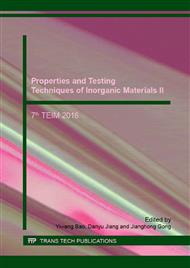[1]
M. Desmaison-Brut, J. Montintin, E. Valin, M. Boncoeur, Influence of processing conditions on the microstructure and mechanical properties of sintered yttrium oxides, Journal of the American Ceramic Society. 78(1995)716–722.
DOI: 10.1111/j.1151-2916.1995.tb08238.x
Google Scholar
[2]
A.L. Micheli, D.F. Dungan, J.V. Mantese, High-density yttria for practical ceramic applications, Journal of the American Ceramic Society. 75(1992)709–711.
DOI: 10.1111/j.1151-2916.1992.tb07863.x
Google Scholar
[3]
A.S. Kumar, A.R. Durai, T. Sornakumar, Yttria ceramics: cutting tool application, Materials Letters. 58(2004)1808–1810.
DOI: 10.1016/j.matlet.2003.11.010
Google Scholar
[4]
I.C. Albayrak, S. Basu, A. Sakulich, O. Yeheskel, M.W. Barsoum, Elastic and mechanical properties of polycrystalline transparent yttria as determined by indentation techniques, Journal of the American Ceramic Society. 93(2010)2028–(2034).
DOI: 10.1111/j.1551-2916.2010.03669.x
Google Scholar
[5]
M. Mori T. Abe, H. Itoh, O. Yamamoto, Cubic-stabilized zirconia and alumina composites as electrolytes in planar type solid oxide fuel cells, Solid State Ionics. 74 (1994) 157-164.
DOI: 10.1016/0167-2738(94)90206-2
Google Scholar
[6]
E. Caproni, F.M.S. Carvalho, R. Muccillo, Development of zirconia–magnesia/ zirconia–yttria composite solid electrolytes, Solid State Ionics. 179 (2008) 1652–1654.
DOI: 10.1016/j.ssi.2008.02.054
Google Scholar
[7]
X.J. Chen, K.A. Khor, S.H. Chan, Influence of microstructure on the ionic conductivity of yttria-stabilized zirconia electrolyte, Journal of Materials Science and Engineering. A. 335 (2002) 246–252.
DOI: 10.1016/s0921-5093(01)01935-9
Google Scholar
[8]
Yuan Ji, Jiang Liu, Zhe Lu, Xin Zhao, Tianmin He, Wenhui Su, Study on the properties of Al2O3 -doped (ZrO2 )0. 92(Y2O3 )0. 08 electrolyte, Solid State Ionics. 126 (1999) 277–283.
DOI: 10.1016/s0167-2738(99)00247-7
Google Scholar
[9]
Yaohui Zhang, Zhe Lü, Xiqiang Huang, Fabrication and performance test of solid oxide fuel cells with screen-printed yttria-stabilized zirconia, Journal of solid state electrochemistry. 11(2010) 2661-2665.
DOI: 10.1007/s10008-010-1257-8
Google Scholar
[10]
D.P.H. Hasselman, Unified theory of thermal shock fracture initiation and crack propagation in brittle ceramics, Journal of the American Ceramic Society. 52(1969)600–604.
DOI: 10.1111/j.1151-2916.1969.tb15848.x
Google Scholar
[11]
F. Tancret, F. Osterstock, The Vickers indentation technique used to evaluate thermal shock resistance of brittle materials, Scripta Materialia. 37(1997)443–447.
DOI: 10.1016/s1359-6462(97)00106-1
Google Scholar
[12]
K. Niihara, R. Morena, D.P.H. Hasselman, Evaluation of KIC of brittle solids by the indentation method with low crack-to-indentrations, Journal of marerials science letters. 1 (1982)13–16.
DOI: 10.1007/bf00724706
Google Scholar
[13]
P. Chantikul, G.R. Anstis, B.R. Lawn, A critical evaluation of indentation techniques for measuring fracture toughness: II, Strength method, Journal of the American Ceramic Society. 64(1981)539–543.
DOI: 10.1111/j.1151-2916.1981.tb10321.x
Google Scholar
[14]
M. Stuer, Z. Zhao, P. Bowen, Freeze granulation: powder processing for transparent alumina applications, Journal of the European Ceramic Society. 32(2012)2899–2908.
DOI: 10.1016/j.jeurceramsoc.2012.02.038
Google Scholar
[15]
G.R. Anstis, P. Chantikul, B.R. Lawn, A critical evaluation of indentation techniques for measuring fracture toughness: I, Direct crack measurements, Journal of the American Ceramic Society. 64(1981)533–538.
DOI: 10.1111/j.1151-2916.1981.tb10320.x
Google Scholar


